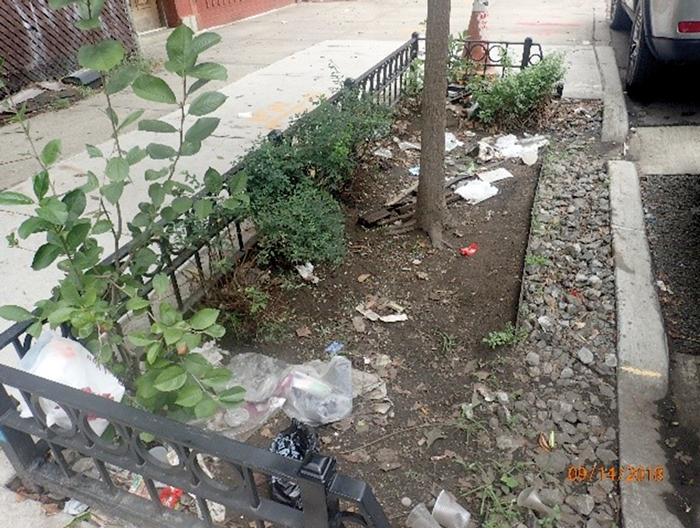Photo Courtesy of Comptroller Stringer’s Office
According to the analysis, there were “visible maintenance deficiencies” at 95 of the 102 rain gardens that auditors visited in Queens, Brooklyn, and the Bronx.
By Michael V. Cusenza
The City’s rain garden initiative is marred by “a dysfunctional maintenance program that wastes taxpayer dollars and puts critical infrastructure at risk,” according to recently released audit by City Comptroller Scott Stringer.
Rain gardens contain plants and engineered soil that are specially designed to absorb and infiltrate large amounts of stormwater and reduce the volume of runoff that enters the City’s combined sewer system where it mixes with wastewater from homes and businesses. Properly maintained rain gardens help control stormwater to minimize sewer overflows from heavy storms that could otherwise pollute the City’s waterbodies, such as Jamaica Bay and tributaries, Alley Creek, the Bronx River, Coney Island Creek, Flushing Bay, Flushing Creek, Gowanus Canal, Hutchinson River, Newtown Creek, Westchester Creek, and the East River and open waters. According to the City Department of Environmental Protection, the agency responsible for managing the 2,511 rain gardens that the City had built as of April 2018 at an estimated construction cost of just over $100 million, well-maintained rain gardens also improve streetscapes and street drainage, help purify the air, and reduce temperatures during hot weather.
According to Stringer’s report, which examined DEP’s maintenance of 102 of the 805 rain gardens that the agency was supposed to fully maintain as of April 2018, there were “visible maintenance deficiencies” at 95 of the 102 rain gardens that auditors visited in Queens, Brooklyn, and the Bronx.
The audit also found:
67 (66 percent) of 102 sampled rain gardens exhibited two or more conditions that DEP’s own Rain Garden Maintenance Manual states can impede their proper functioning, including: sediment buildup in the rain gardens’ gravel strips, planting areas, and curb cuts; compacted and depleted soil that needed to be raked and replenished; weeds and overgrown plants that needed pruning; and missing plants and trees.
53 (52 percent) of the sampled rain gardens were marred by two or more unsightly conditions, such as trash, weeds, overgrown grass, and missing plants.
29 percent had four or more deficient conditions.
Just seven of the 102 sampled rain gardens had no visible deficiencies.
“The City built thousands of rain gardens to help control stormwater and protect our waterways, streets, homes, and small businesses, but our audit uncovered a dysfunctional maintenance program that wastes taxpayer dollars and puts critical infrastructure at risk,” Stringer said. “DEP must step up to the plate and properly maintain these vital resources. We cannot win the battle to protect New Yorkers against the next superstorm and keep our waterways clean if we allow these vital resources to fall into disrepair due to neglect.”
In its response to the audit findings and Stringer’s 18 recommendations to DEP to improve maintenance of the agency’s rain gardens, the agency stated that it “agrees with, and has largely implemented most of the recommendations contained in the report” but also stated that it disagrees with three of them.
“We have reviewed the report and have significant concerns with the report’s findings and recommendations,” DEP officials added.

